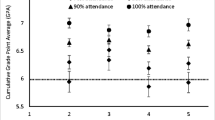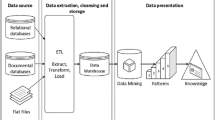Abstract
Given gaps in both identifying and providing targeted interventions to struggling learners, the purpose of this study is to both improve rapid identification and to improve individualized academic advising for learners using this visual representation of performance. Across three graduating classes, individual growth curves were calculated for each student on National Board of Medical Examiners customized assessments during the pre-clerkship period using their deviation from the class average at each assessment point. These deviation scores were cumulatively summed over time and were regressed onto the sequence of exams. We analyzed the difference between the regression slopes of those students placed on Academic Probation (AP) versus not, as well as differences in slopes based on the timing of when a struggling learner was placed on AP to explore learner trajectory after identification. Students on AP had an average growth slope of − 6.06 compared to + 0.89 for those not on AP. Findings also suggested that students who were placed on AP early during pre-clerkship showed significant improvement (positive changes in trajectory) compared to students identified later in the curriculum. Our findings suggest that earlier academic probation and intervention with struggling learners may have a positive effect on academic trajectory. Future research can better explore how academic trajectory monitoring and performance review can be regularly used in advising sessions with students.




Similar content being viewed by others
References
American Association of Medical Colleges. 2020 FACTS: Applicants and Matriculants Data. (n.d.). Retrieved July 17, 2021 from https://www.aamc.org/data-reports/students-residents/interactive-data/2020-facts-applicants-and-matriculants-data
Boscardin, C., Fergus, K. B., Hellevig, B., & Hauer, K. E. (2018). Twelve tips to promote successful development of a learner performance dashboard within a medical education program. Medical Teacher, 40, 855–861.
Bennion, L. D., Durning, S. J., LaRochelle, J., Yoon, M., Schreiber-Gregory, D., Reamy, B. V., & Torre, D. (2018). Untying the Gordian knot: Remediation problems in medical schools that need remediation. BMC Medical Education, 18, 120.
Cendán, J. C., Joledo, O., Soborowicz, M. B., Marchand, L., & Selim, B. R. (2018). Using assessment point accumulation as a guide to identify students at risk for interrupted academic progress. Academic Medicine, 93, 1663–1667.
Cook, D. A., Brydges, R., Ginsburg, S., & Hatala, R. (2015). A contemporary approach to validity arguments: A practical guide to Kane’s framework. Medical Education, 49, 560–575.
Daniel, M., Fleming, A., O’Conner Grochowski, C., Harnik, V., Klimstra, S., Morrison, G., Pock, A., et al. (2017). Why not wait? Eight institutions share their experiences moving United States Medical Licensing Exam Step 1 after core clinical clerkships. Academic Medicine, 92, 1515–1524.
Freeman, A., van der Vleuten, C., Nouns, Z., & Ricketts, C. (2010). Progress testing internationally. Medical Teacher, 32, 451–455.
Frellsen, S. L., Baker, E. A., Papp, K. K., & Durning, S. J. (2008). Medical school policies regarding struggling medical students during internal medicine clerkships: Results of a national survey. Academic Medicine, 9, 876–881.
Harryson, I. J., Cook, J., Sirimann, P., Feldman, L. S., Darzi, A., & Aggarwal, R. (2014). Systematic review of learning curves for minimally invasive abdominal surgery: A review of the methodology of data collection, depiction of outcomes, and statistical analysis. Annals of Surgery, 260, 37–45.
Hatala, R., Gutman, J., Lineberry, M., Triola, M., & Pusic, M. (2019). How well is each learner learning? Validity investigation of a learning curve-based assessment approach for ECG interpretation. Advances in Health Sciences Education, 24, 45–63.
Heeneman, S., Oudkerk Pool, A., Schuwirth, L. W., van der Vleuten, C. P., & Driessen, E. W. (2015). The impact of programmatic assessment on student learning: Theory versus practice. Medical Education, 49, 487–498.
Hosmer, D. W., & Lemeshow, S. (2000). Applied logistic regression (2nd ed., pp. 160–164). John Wiley and Sons.
Irby, D. M., & Wilkerson, L. (2003). Educational innovations in academic medicine and environmental trends. Journal of General Internal Medicine, 18, 370–376.
Kalet, A., & Chou, C. L. (Eds.). (2014). Remediation in medical education. Springer.
Kane, M. T. (2013). Validating the interpretations and uses of test scores. Journal of Educational Measurement, 50, 1–73.
Li, J., Thompson, R., & Shulruf, B. (2019). Struggling with strugglers: Using data from selection tools for early identification of medical students at risk of failure. BMC Medical Education, 19, 415.
McOwen K. S., & Farmakidis, A. L. (2020). A snapshot of medical student education in the United States and Canada: Reports from 145 schools. Academic Medicine, 95, September 2020 Supplement.
Monrad, S. U., Mangrulkar, R. S., Woolliscroft, J. O., Daniel, M. M., Hartley, S. E., Gay, T. L., Highet, A., Vijayakumar, N., & Santen, S. A. (2019). Competency committees in undergraduate medical education: Approaching tensions using a polarity management framework. Academic Medicine, 94(12), 1865–1872.
Muller, D., & Kase, N. (2010). Challenging traditional premedical requirements as predictors of success in medical school: The Mount Sinai School of Medicine Humanities and Medicine Program. Academic Medicine, 85, 1378–1383.
National Board of Medical Examiners. Customized Assessment Services. National Board of Medical Examiners website. Accessed July 4, 2020. https://www.nbme.org/assessment-products/assess-learn/customized-assessments-services-cas
Pusic, M., Pecaric, M., & Boutis, K. (2011). How much practice is enough? Using learning curves to assess the deliberate practice of radiograph interpretation. Academic Medicine, 86, 731–736.
Saks, N., Rashid, H., & Lebeau, R. (2016) A National Survey of US Medical Schools: Current Status of Academic Support. [PowerPoint presentation]. AAMC (Association of American Medical Colleges) Annual Conference, Seattle, WA.
Schuwirth, L. W. T., & van der Vleuten, C. P. M. (2011). Programmatic assessment: From assessment of learning to assessment for learning. Medical Teacher, 33, 478–485.
Stegers-Jager, K. M., Cohen-Schotanus, J., Splinter, T. A. W., & Themmen, A. P. N. (2011). Academic dismissal policy for medical students: Effect on study progress and help-seeking behavior. Medical Education, 45, 987–994.
Tavares, W., Brydges, R., Myre, P., Prpic, J., Turner, L., Yelle, R., & Huiskamp, M. (2018). Applying Kane’s validity framework to a simulation based assessment of clinical competence. Advances in Health Sciences Education, 23, 323–338.
Watling, C., Driessen, E., van der Vleuten, C. P. W., & Lingard, L. (2014). Learning culture and feedback: An international study of medical athletes and musicians. Medical Education, 48, 713–723.
Wilkerson, L., Stevens, C. M., & Krasne, S. (2009). No content without context: Integrating basic, clinical, and social sciences in a pre-clerkship curriculum. Medical Teacher, 31, 813–821.
Yates, J., & James, D. (2006). Predicting the “strugglers”: A case-control study of students at Nottingham University Medical School. BMJ, 332, 1009.
Author information
Authors and Affiliations
Corresponding author
Ethics declarations
Disclaimers
The opinions and assertions expressed herein are those of the authors and do not necessarily reflect the official policy or position of the Uniformed Services University or the Department of Defense.
Additional information
Publisher's Note
Springer Nature remains neutral with regard to jurisdictional claims in published maps and institutional affiliations.
Rights and permissions
About this article
Cite this article
Landoll, R.R., Bennion, L.D., Maranich, A.M. et al. Extending growth curves: a trajectory monitoring approach to identification and interventions in struggling medical student learners. Adv in Health Sci Educ 27, 645–658 (2022). https://doi.org/10.1007/s10459-022-10109-7
Received:
Accepted:
Published:
Issue Date:
DOI: https://doi.org/10.1007/s10459-022-10109-7




